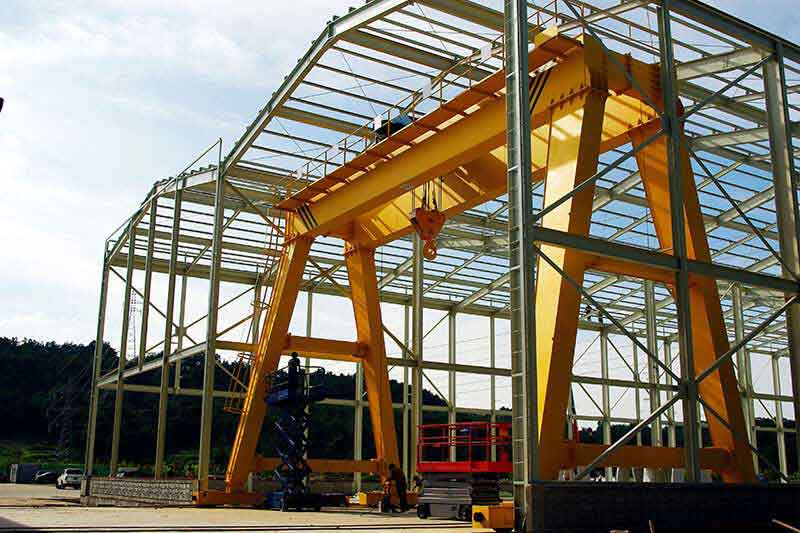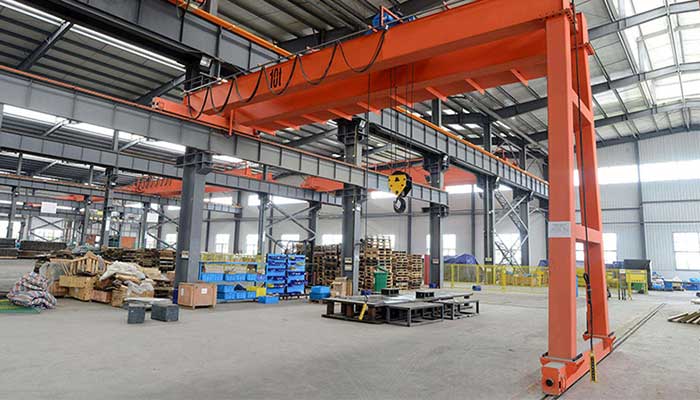Gantry Cranes for Outdoor Large-Scale Panel Production
10 to 50 tons Gantry crane for sale. Check types of gantry cranes and its applications in handling heavy precast concrete panels in outdoor precast yards.
Gantry Cranes for Outdoor Large-Scale Panel Production
In the intricate dance of construction, where precision and efficiency intertwine, gantry cranes emerge as stalwart partners in the realm of large-scale panel production. These towering mechanical marvels play a pivotal role in the seamless handling of heavy precast concrete panels within the expansive outdoor spaces of precast yards. Their significance extends beyond mere lifting; they are the orchestrators of material handling, bringing finesse to the manufacturing process.
Efficiency is the heartbeat of large-scale panel production, and at its core is the precise choreography of material handling facilitated by gantry cranes. These industrial workhorses optimize efficiency by navigating through the intricacies of the outdoor environment, lifting, and transporting substantial precast concrete panels with unparalleled accuracy. The impact of this efficiency ripples through the entire production process, influencing timelines, costs, and, most importantly, the quality of the end product. As we delve into the world of gantry cranes, their diverse types, and their applications in managing loads ranging from 10 to 50 tons, the essential role they play becomes increasingly apparent.
Types of Gantry Cranes Used
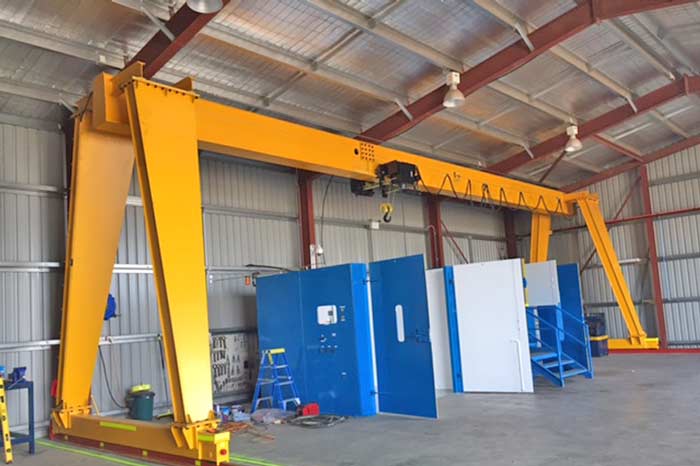
Single Girder Gantry Cranes
In the realm of outdoor large-scale panel production, Single Girder Gantry Cranes stand as versatile workhorses with a distinctive design. Characterized by a single horizontal beam, they boast moderate lifting capacities, making them adept at handling the intricacies of smaller formwork components. Their nimble design allows them to navigate seamlessly through confined outdoor spaces, ensuring precise material handling in even the most intricate layouts.
While their primary function lies in the meticulous handling of smaller formwork components, Single Girder Gantry Cranes extend their capabilities to a broader spectrum of tasks in outdoor precast yards. From efficiently managing smaller precast concrete elements to showcasing versatility in various material handling assignments, these cranes become indispensable assets in the dynamic workflow of large-scale panel production. Their adaptability ensures that they play a pivotal role in enhancing overall efficiency and precision.
In the grand orchestration of outdoor large-scale panel production, Double Girder Gantry Cranes take center stage with a design that exudes robust stability. Featuring two horizontal beams, these cranes elevate their lifting capacities to handle the weightier aspects of the manufacturing process. Ideal for lifting larger mold sections and assembled formwork, their structure ensures not only strength but also precision in the placement of substantial formwork elements. This design choice makes them indispensable in the seamless assembly of heavy precast concrete components.
The prowess of Double Girder Gantry Cranes extends far beyond the realm of formwork. Their strength and stability make them adept at handling heavy precast concrete components with unparalleled precision. In the dynamic environment of outdoor large-scale panel production, where stability and higher lifting capacities are paramount, these cranes find their niche. Whether it's the meticulous placement of substantial elements or the execution of various tasks demanding stability, Double Girder Gantry Cranes stand as reliable pillars supporting the efficiency and success of the production process.
In the intricate dance of outdoor large-scale panel production, Semi Gantry Cranes gracefully merge the features of both gantry and overhead cranes. Their adaptable design is tailored for handling diverse formwork configurations, providing a solution for the ever-changing requirements of the manufacturing process. With one end gracefully supported on a fixed runway and the other on wheels, these cranes offer a dynamic approach to material handling in outdoor precast yards. This unique design allows for efficient navigation through confined spaces, ensuring flexibility and precision.
Semi Gantry Cranes bring a touch of versatility to the outdoor production landscape. Beyond their primary role in handling formwork, these cranes showcase efficiency in the transportation of precast concrete components. Their adaptability shines as they navigate through outdoor spaces with limited layout constraints, providing a solution to the challenges posed by dynamic manufacturing environments. Whether handling formwork of varying sizes and shapes or efficiently transporting precast concrete components, Semi Gantry Cranes carve a niche for themselves in the intricate ballet of outdoor large-scale panel production.
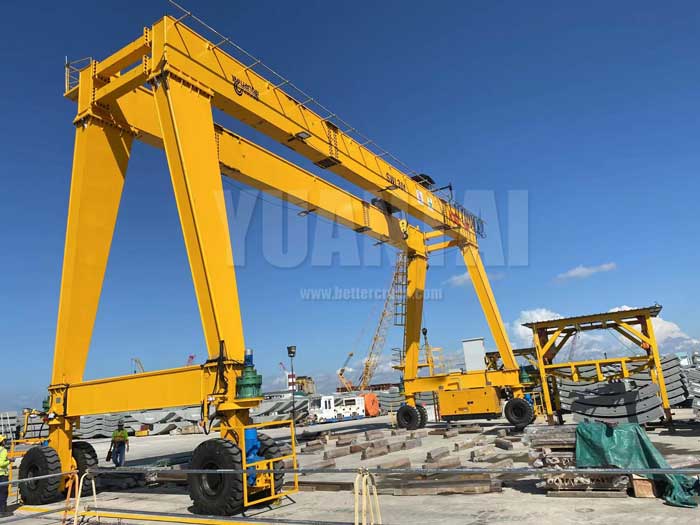
Rubber-Tired Gantry Cranes (RTG)
In the bustling theater of outdoor large-scale panel production, Rubber-Tired Gantry Cranes (RTG) emerge as nimble performers, equipped with features tailored for enhanced mobility. Their design, adorned with rubber tires, allows for agile navigation through the expansive precast yards. With a remarkable 360-degree movement capability, these cranes bring a touch of versatility to the outdoor production stage. RTGs are crafted to handle mid-range loads with finesse, making them indispensable players in the orchestration of material handling in the outdoor fabrication of precast concrete panels.
Beyond the realm of formwork assembly, RTGs showcase their prowess in efficiently transporting raw materials essential for large-scale panel production. From aggregates to concrete mixtures, these cranes become the logistical backbone, ensuring a steady flow of resources to the manufacturing process. Their versatility shines through as they seamlessly engage in various material handling tasks within outdoor precast yards. In the dynamic and ever-moving landscape of large-scale panel production, Rubber-Tired Gantry Cranes prove to be agile performers, contributing to the efficiency and success of the production process.
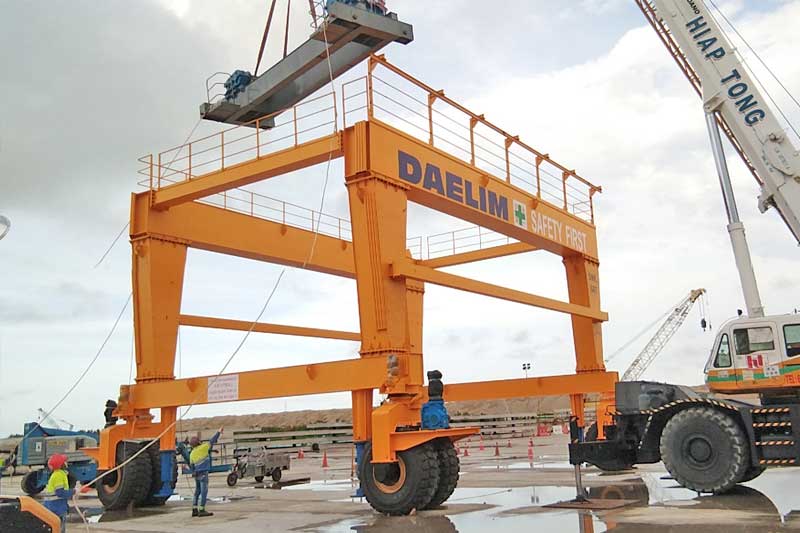
Rail-Mounted Gantry Cranes (RMG)
In the precision-driven arena of outdoor large-scale panel production, Rail-Mounted Gantry Cranes (RMG) take center stage with a design tailored for stability and accuracy. Operating on a fixed rail system, these cranes offer a stable foundation for the meticulous handling of precast concrete panels. Their design is intricately crafted for precise positioning during formwork assembly, minimizing sway, and ensuring unfaltering accuracy in movements. RMGs become the architects of controlled and stable material handling in the dynamic outdoor environment.
RMGs extend their influence beyond the realms of formwork assembly, showcasing their prowess in handling larger precast elements with unparalleled control. Their ability to optimize workflow by ensuring accurate and stable lifting becomes paramount in the intricate dance of large-scale panel production. As they navigate the fixed rail system, Rail-Mounted Gantry Cranes become indispensable tools in the efficient and precise handling of precast elements, contributing significantly to the success of the production process.
Managing Loads in the 10 to 50 Ton Range
Large-scale panel production presents a unique set of challenges, particularly when it comes to managing loads ranging from 10 to 50 tons. Understanding the intricacies of these weight ranges is crucial for ensuring the seamless flow of the production process. Gantry cranes, with their diverse designs and capabilities, play a pivotal role in navigating these challenges and ensuring precision in lifting and transporting substantial precast concrete panels.
The weight range of 10 to 50 tons introduces a spectrum of challenges that demand careful consideration in the production of large-scale panels. The sheer mass of these precast concrete elements requires specialized handling to maintain efficiency and safety. Factors such as the dimensions, material composition, and intended use of the panels further add complexity to the weight range challenges.
Gantry Cranes as Precision Managers
Different types of gantry cranes are strategically employed to manage loads within the 10 to 50-ton range. Each type brings its unique set of features and capabilities to address specific aspects of the weight range challenges.
- Single Girder Gantry Cranes: With a focus on moderate lifting capacities, these cranes are adept at handling smaller formwork components within the weight range. Their agility and precise control make them suitable for navigating through confined outdoor spaces, ensuring careful handling of mid-range loads.
- Double Girder Gantry Cranes: Designed for increased stability and lifting capacity, double girder gantry cranes take on the challenge of handling larger mold sections and assembled formwork within the weight range of 10 to 50 tons. Their robust structure ensures the precise placement of substantial formwork elements.
- Semi Gantry Cranes: By combining features of both gantry and overhead cranes, semi gantry cranes offer adaptability in handling diverse formwork configurations. This versatility makes them effective in managing loads of varying sizes and shapes within the specified weight range.
- Rubber-Tired Gantry Cranes (RTG): Equipped with rubber tires for enhanced mobility, RTGs bring agility to the handling of mid-range loads. Their 360-degree movement capability allows for agile navigation, ensuring efficient transportation of precast concrete components within the weight range.
- Rail-Mounted Gantry Cranes (RMG): Operating on a fixed rail system, RMGs provide stability and controlled movements, making them ideal for handling larger precast elements within the specified weight range. Their precision in positioning ensures accurate and stable lifting.
The precision demanded in large-scale panel production goes beyond lifting capacity. Gantry cranes, with their carefully engineered designs, ensure accuracy in every movement. Whether it's the placement of formwork, transportation of precast components, or the meticulous handling of heavy elements, these cranes contribute to the overall precision required in the production process.
As we delve deeper into the intricate dance of gantry cranes managing loads within the 10 to 50-ton range, their role becomes increasingly apparent in sculpting the success and efficiency of outdoor large-scale panel production.
Advantages Beyond Panel Production
As stalwart performers in outdoor large-scale panel production, gantry cranes extend their influence far beyond the confines of formwork assembly. Their versatility becomes a cornerstone for various functions within the precast yard, contributing to a seamless and efficient production workflow. Let's explore the advantages that gantry cranes bring beyond the realm of panel production.
Handling Raw Materials with Precision
- Efficient Transportation of Raw Materials: Gantry cranes, with their robust designs and diverse types, prove invaluable in the transportation of raw materials. From aggregates to concrete mixtures and reinforcements, these cranes ensure a steady and efficient flow of essential resources to the production site.
- Agile Navigation for Raw Material Handling: The mobility of certain gantry crane types, such as Rubber-Tired Gantry Cranes (RTG), allows for agile navigation within the precast yard. This agility enhances the efficiency of handling raw materials of varying sizes and shapes.
Optimizing Overall Production Workflows
- Versatile Material Handling: The adaptability of gantry cranes to handle different types of loads, including raw materials and precast components, contributes to the overall versatility of the production workflow. This versatility ensures that these cranes can seamlessly transition between various tasks, minimizing downtime and optimizing efficiency.
- Precision in Formwork Assembly: Gantry cranes play a pivotal role in the precision assembly of formwork, ensuring accurate placement of mold sections and components. This precision is crucial for maintaining the quality standards of precast concrete panels.
Contributing to Efficiency and Sustainability
Energy-Efficient Solutions: Some gantry crane types are designed with energy efficiency in mind. The integration of smart crane systems and technological advancements contributes to minimizing energy consumption, aligning with sustainability initiatives in modern production facilities.
Eco-Friendly Materials Handling: Gantry cranes contribute to the eco-friendliness of the facility by enabling efficient and controlled material handling. This not only enhances overall efficiency but also aligns with sustainable practices in the construction industry.
In essence, the advantages of gantry cranes extend beyond their primary role in panel production. Their adaptability, precision, and contribution to overall efficiency make them integral players in the broader spectrum of functions within outdoor precast yards. As these cranes navigate through the challenges of handling raw materials and optimizing workflows, they become catalysts for the sustained success and sustainability of the entire facility.
Challenges and Solutions
The outdoor environment, while expansive and conducive to large-scale panel production, introduces its own set of challenges for gantry cranes. Navigating varying weather conditions, ensuring optimal performance, and prioritizing safety become paramount considerations. This section explores the challenges faced during outdoor large-scale panel production and the innovative solutions implemented to overcome them.
Addressing Outdoor Challenges in Large-Scale Panel Production
Challenge 1: Weather Variability
The unpredictable nature of weather conditions is a constant challenge in outdoor panel production, impacting gantry crane operations and overall production schedules. Various weather elements such as rain, wind, and extreme temperatures can pose significant risks.
Impact on Crane Operations:
Rain and Moisture:
Challenge: Continuous or heavy rainfall can lead to corrosion and affect the performance of crane components.
Impact on Production: Operations may be halted, impacting material handling, formwork assembly, and panel placement.
Wind Gusts: Challenge
Strong winds can compromise the stability and precision of crane operations.
Impact on Production: Adjustments or pauses may be required, affecting workflow efficiency and safety.
Extreme Temperatures:
Challenge: Extreme heat or cold can impact crane components, leading to potential mechanical issues.
Impact on Production: Crane performance may be compromised, requiring additional maintenance.
Solution 1: Weather-Resistant Crane Designs
Gantry cranes designed with weather-resistant features play a crucial role in mitigating the impact of adverse weather conditions. Key elements of these designs include:
- Corrosion-Resistant Materials: Incorporating materials that resist corrosion, such as stainless steel or specialized coatings, enhances the durability of crane components.
- Protective Coatings: Applying protective coatings to crane surfaces provides an additional layer of defense against moisture, preventing rust and deterioration.
These enhancements ensure the longevity and sustained performance of gantry cranes in challenging outdoor settings, minimizing the impact of weather variability.
Solution 2: Advanced Weather Monitoring Systems
The integration of advanced weather monitoring systems provides real-time data on current and upcoming weather conditions. Key aspects of these systems include:
- Real-Time Data: Continuous monitoring of weather conditions allows for proactive decision-making based on accurate, up-to-date information.
- Predictive Analytics: Utilizing predictive analytics enables construction teams to anticipate adverse weather events and plan accordingly.
This solution empowers construction managers to adjust production schedules or temporarily cease operations during severe weather events, ensuring the safety of personnel and equipment.
Solution 3: Spatial Optimization Through Smart Systems
Smart crane systems with spatial awareness capabilities are instrumental in optimizing the use of available space in outdoor precast yards. Features of these systems include:
- Collision Avoidance: Smart systems can detect potential collisions and automatically adjust crane movements to avoid accidents.
- Spatial Awareness: Gantry cranes equipped with spatial awareness capabilities can navigate efficiently within confined spaces, maximizing material handling and formwork assembly.
These solutions facilitate efficient material handling and formwork assembly, maximizing productivity within the spatial constraints of outdoor precast yards. Smart systems contribute to the overall optimization of crane operations, ensuring a seamless and safe production process.
Ensuring Safety Measures in Outdoor Environments
The dynamic outdoor environment introduces potential risks to personnel involved in gantry crane operations. Safety measures are paramount to prevent accidents and ensure the well-being of workers who are an integral part of the production process.
Impact on Safety:
Dynamic Environment: Challenge: Changing weather conditions and spatial constraints pose challenges to the safety of personnel working around gantry cranes.
Risk Factors: Potential accidents, slips, trips, and falls may occur due to unpredictable outdoor conditions.
Challenge 4: Equipment Safety
The exposure of gantry cranes to outdoor elements necessitates robust safety features to protect the equipment from damage and maintain operational integrity.
Impact on Crane Equipment:
Exposure to Elements: Challenge: Outdoor elements such as rain, wind, and temperature variations can impact crane components.
Risk Factors: Mechanical issues, corrosion, and wear and tear may compromise the safety and operational efficiency of gantry cranes.
Solution 4: Comprehensive Safety Training
Comprehensive safety training for crane operators and personnel working in the outdoor environment is an essential component of addressing personnel safety challenges. Key elements of this solution include:
- Adverse Weather Protocols: Training programs should include protocols for adverse weather conditions, guiding operators on how to respond to changing weather dynamics.
- Emergency Response Procedures: Personnel should be equipped with knowledge and training in emergency response procedures to ensure swift and effective actions during unforeseen events.
This solution not only enhances the safety awareness of personnel but also empowers them to navigate and operate gantry cranes in challenging outdoor conditions with a focus on accident prevention.
Solution 5: Enhanced Safety Features in Crane Design
Gantry cranes equipped with enhanced safety features play a crucial role in mitigating risks associated with both personnel and equipment safety. These features include:
- Collision Avoidance Systems: Automated systems that detect potential collisions and adjust crane movements to avoid accidents.
- Emergency Braking Mechanisms: Rapid response braking mechanisms that can be activated in emergency situations to prevent accidents.
- Load Monitoring Technology: Systems that monitor the load being lifted, providing real-time data to prevent overloading and ensure safe lifting operations.
These features contribute to a safer working environment by mitigating the risk of accidents, ensuring the longevity of the equipment, and protecting personnel involved in gantry crane operations.
In conclusion, ensuring safety measures in outdoor environments requires a holistic approach, encompassing comprehensive training for personnel and the integration of advanced safety features in gantry crane design. This dual-focused strategy promotes a secure and efficient working environment, fostering the well-being of both workers and equipment in the dynamic outdoor setting.
In the dance between gantry cranes and the challenges presented by outdoor large-scale panel production, the implementation of innovative solutions ensures a harmonious performance. As the industry continues to evolve, addressing challenges and prioritizing safety will remain central to the success of outdoor precast operations.
Conclusion
As we conclude our exploration into the realm of gantry cranes in outdoor large-scale panel production, it is paramount to recapitulate the pivotal role these machines play in shaping the efficiency, precision, and overall success of the precast concrete industry.
Gantry cranes, with their diverse types and capabilities, have demonstrated an indispensable role in the outdoor fabrication of large-scale precast concrete panels. From the handling of raw materials to the precise placement of formwork components, these cranes have showcased efficiency and versatility. The ability to navigate through varying weather conditions, spatial constraints, and challenging environments underscores their adaptability.
The case studies and success stories highlighted the tangible impact of gantry cranes on increased efficiency, precision in formwork assembly, and the overall quality of precast concrete panels. Whether handling smaller loads with single girder cranes or managing substantial components with double girder cranes, each type of gantry crane contributes uniquely to the success of outdoor panel production.
As the construction industry continues to evolve, the continued significance of gantry cranes in outdoor precast concrete production cannot be overstated. Their reliability, precision, and adaptability align seamlessly with the demands of modern construction landscapes. The emphasis on sustainability, safety, and efficiency makes gantry cranes pivotal assets for construction firms striving for excellence.
In acknowledging the unwavering contributions of gantry cranes, we recognize not only their current importance but also their potential to shape the future of large-scale panel production. As technologies advance and construction methodologies evolve, gantry cranes stand as stalwart companions, facilitating progress and innovation in the ever-changing world of precast concrete construction.
In essence, gantry cranes are not just machines; they are partners in progress, elevating the standards of efficiency and precision in outdoor precast concrete production. As we look ahead, their role will undoubtedly continue to be a defining force in shaping the landscapes of construction and precast manufacturing.


